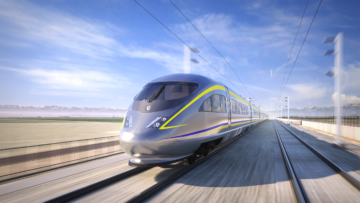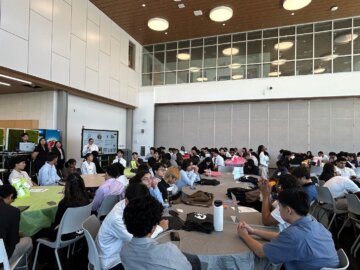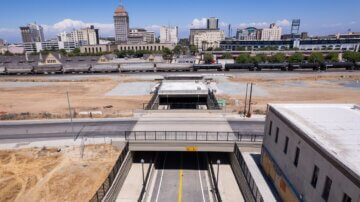|
ਮੁੱਖ ਖ਼ਬਰਾਂ |
ਸਹਿਭਾਗੀ ਅੱਪਡੇਟ |
ਆਊਟਰੀਚ ਅੱਪਡੇਟ |
ਕੈਲੀਫੋਰਨੀਆ ਹਾਈ-ਸਪੀਡ ਰੇਲ ਲਈ ਸਥਿਰ ਫੰਡਿੰਗ ਸਮਝੌਤੇ ਨਾਲ ਅੱਗੇ ਵਧਦਾ ਹੈ

ਗਵਰਨਰ ਨਿਊਸਮ ਕੈਲੀਫੋਰਨੀਆ ਦੇ ਕੈਪ-ਐਂਡ-ਇਨਵੈਸਟ ਪ੍ਰੋਗਰਾਮ ਨੂੰ ਵਧਾਉਣ ਵਾਲੇ ਕਾਨੂੰਨ ਲਈ ਦਸਤਖਤ ਸਮਾਰੋਹ ਵਿੱਚ ਬੋਲਦੇ ਹਨ।
19 ਸਤੰਬਰ ਨੂੰ, ਗਵਰਨਰ ਗੈਵਿਨ ਨਿਊਸਮ ਨੇ ਕੈਪ-ਐਂਡ-ਇਨਵੈਸਟ ਪ੍ਰੋਗਰਾਮ ਨੂੰ ਮੁੜ ਅਧਿਕਾਰਤ ਕਰਨ ਅਤੇ 2045 ਤੱਕ ਕੈਲੀਫੋਰਨੀਆ ਹਾਈ-ਸਪੀਡ ਰੇਲ ਅਥਾਰਟੀ (ਅਥਾਰਟੀ) ਲਈ ਸਾਲਾਨਾ $1 ਬਿਲੀਅਨ ਦੀ ਇਤਿਹਾਸਕ ਵਚਨਬੱਧਤਾ ਪ੍ਰਦਾਨ ਕਰਨ ਲਈ ਰਾਜ ਵਿਧਾਨ ਸਭਾ ਨਾਲ ਗੱਲਬਾਤ ਕੀਤੇ ਗਏ ਇੱਕ ਸਮਝੌਤੇ 'ਤੇ ਹਸਤਾਖਰ ਕੀਤੇ। ਇਹ ਪ੍ਰੋਗਰਾਮ ਲਈ ਹੁਣ ਤੱਕ ਸੁਰੱਖਿਅਤ ਫੰਡਿੰਗ ਦਾ ਸਭ ਤੋਂ ਵੱਡਾ ਗਾਰੰਟੀਸ਼ੁਦਾ ਨਿਵੇਸ਼ ਹੈ।
ਸੀਈਓ ਇਆਨ ਚੌਧਰੀ ਨੇ ਇਸ ਸਮਝੌਤੇ ਨੂੰ "ਕੈਲੀਫੋਰਨੀਆ ਦੇ ਭਵਿੱਖ ਬਾਰੇ ਇੱਕ ਵੱਡਾ, ਦਲੇਰਾਨਾ ਬਿਆਨ ਕਿਹਾ - ਜੋ ਨੌਕਰੀਆਂ ਪੈਦਾ ਕਰੇਗਾ, ਪ੍ਰਦੂਸ਼ਣ ਘਟਾਏਗਾ, ਅਤੇ ਰਾਜ ਭਰ ਦੇ ਭਾਈਚਾਰਿਆਂ ਨੂੰ ਜੋੜੇਗਾ ਅਤੇ ਬਦਲ ਦੇਵੇਗਾ।"
ਇਹ ਹਾਈ-ਸਪੀਡ ਰੇਲ ਪ੍ਰੋਜੈਕਟ ਨੂੰ ਇੱਕ ਸਥਿਰ ਅਤੇ ਅਨੁਮਾਨਯੋਗ ਫੰਡਿੰਗ ਸਟ੍ਰੀਮ ਪ੍ਰਦਾਨ ਕਰੇਗਾ, ਜਿਸ ਨਾਲ ਵਧੇਰੇ ਨਿਸ਼ਚਤਤਾ ਅਤੇ ਵਧੇਰੇ ਕੁਸ਼ਲ ਪ੍ਰੋਜੈਕਟ ਡਿਲੀਵਰੀ ਨਾਲ ਯੋਜਨਾਬੰਦੀ ਕੀਤੀ ਜਾ ਸਕੇਗੀ। ਗਾਰੰਟੀਸ਼ੁਦਾ ਫੰਡਿੰਗ ਪ੍ਰੋਜੈਕਟ ਦੀ ਨਿੱਜੀ ਪੂੰਜੀ ਨੂੰ ਆਕਰਸ਼ਿਤ ਕਰਨ ਅਤੇ ਮੌਜੂਦਾ ਫੰਡਾਂ ਨੂੰ ਪਹਿਲਾਂ ਤੋਂ ਹੀ ਲਾਭ ਪਹੁੰਚਾਉਣ ਦੀ ਸਮਰੱਥਾ ਨੂੰ ਵੀ ਬਿਹਤਰ ਬਣਾਉਂਦੀ ਹੈ, ਡਿਲੀਵਰੀ ਨੂੰ ਤੇਜ਼ ਕਰਦੀ ਹੈ ਅਤੇ ਲੰਬੇ ਸਮੇਂ ਦੀਆਂ ਲਾਗਤਾਂ ਨੂੰ ਘਟਾਉਂਦੀ ਹੈ।
ਇਹ ਘੱਟੋ-ਘੱਟ ਫੰਡਿੰਗ ਪੱਧਰ ਅਤੇ 15-ਸਾਲ ਦਾ ਵਾਧਾ ਸੈਂਟਰਲ ਵੈਲੀ ਵਿੱਚ ਮਰਸਡ ਤੋਂ ਬੇਕਰਸਫੀਲਡ ਹਿੱਸੇ ਨੂੰ ਬਣਾਉਣ ਦੀ ਲਾਗਤ ਨੂੰ ਪੂਰਾ ਕਰੇਗਾ, ਫੰਡਿੰਗ ਵਿੱਚ ਕਿਸੇ ਵੀ ਪਾੜੇ ਨੂੰ ਪ੍ਰਭਾਵਸ਼ਾਲੀ ਢੰਗ ਨਾਲ ਪੂਰਾ ਕਰੇਗਾ।
ਇਸ ਫੰਡਿੰਗ ਬਾਰੇ ਹੋਰ ਇੱਥੇ ਪੜ੍ਹੋ.
ਸੀਈਓ ਇਆਨ ਚੌਧਰੀ ਨੇ ਪਹਿਲੇ ਸਾਲ ਵਿੱਚ ਹਾਈ-ਸਪੀਡ ਰੇਲ ਲਈ ਨਵਾਂ ਦ੍ਰਿਸ਼ਟੀਕੋਣ ਸਾਂਝਾ ਕੀਤਾ
ਅਗਸਤ 2024 ਵਿੱਚ, ਅਥਾਰਟੀ ਦੇ ਡਾਇਰੈਕਟਰ ਬੋਰਡ ਨੇ ਪ੍ਰੋਗਰਾਮ ਨੂੰ ਯੋਜਨਾਬੰਦੀ ਤੋਂ ਸੰਚਾਲਨ ਵਿੱਚ ਤਬਦੀਲ ਕਰਨ ਲਈ ਪ੍ਰੋਗਰਾਮ ਦੇ ਨਵੇਂ ਸੀਈਓ ਵਜੋਂ ਇਆਨ ਚੌਧਰੀ ਦੀ ਚੋਣ ਨੂੰ ਮਨਜ਼ੂਰੀ ਦੇ ਦਿੱਤੀ। ਉਦੋਂ ਤੋਂ, ਉਸਨੇ ਅਥਾਰਟੀ ਨੂੰ ਇੱਕ ਕਾਰੋਬਾਰ ਵਾਂਗ ਚਲਾਉਣ ਲਈ ਪੁਨਰਗਠਨ ਕੀਤਾ ਹੈ, ਕੁਸ਼ਲਤਾ, ਜਵਾਬਦੇਹੀ ਅਤੇ ਤੇਜ਼ ਅਮਲ ਨੂੰ ਯਕੀਨੀ ਬਣਾਇਆ ਹੈ। ਆਪਣੇ ਪਹਿਲੇ ਸਾਲ ਵਿੱਚ, ਸੀਈਓ ਚੌਧਰੀ ਨੇ ਪ੍ਰੋਗਰਾਮ ਲਈ ਨਵੀਂ ਦਿਸ਼ਾ 'ਤੇ ਰਾਜ ਦੇ ਉੱਪਰ ਅਤੇ ਹੇਠਾਂ ਆਵਾਜਾਈ ਹਿੱਸੇਦਾਰਾਂ ਅਤੇ ਸਥਾਨਕ ਭਾਈਵਾਲਾਂ ਨਾਲ ਜੁੜਿਆ ਹੈ। ਇਹਨਾਂ ਤਬਦੀਲੀਆਂ ਦੇ ਨਾਲ, ਸੀਈਓ ਚੌਧਰੀ ਦੁਨੀਆ ਭਰ ਦੇ ਦਰਸ਼ਕਾਂ, ਜਿਸ ਵਿੱਚ ਨਿੱਜੀ ਖੇਤਰ ਵੀ ਸ਼ਾਮਲ ਹੈ, ਤੋਂ ਸਮਰਥਨ ਅਤੇ ਦਿਲਚਸਪੀ ਵੀ ਆਕਰਸ਼ਿਤ ਕਰ ਰਿਹਾ ਹੈ, ਇਹ ਦਿਖਾ ਕੇ ਕਿ ਅਥਾਰਟੀ ਤੇਜ਼, ਚੁਸਤ ਅਤੇ ਵਧੇਰੇ ਆਰਥਿਕ ਤੌਰ 'ਤੇ ਪ੍ਰਦਾਨ ਕਰਨ ਲਈ ਇੱਕ ਦਲੇਰ ਨਵੇਂ ਰਸਤੇ 'ਤੇ ਹੈ। ਇੱਥੇ ਕੁਝ ਮੁੱਖ ਗੱਲਾਂ 'ਤੇ ਇੱਕ ਝਾਤ ਮਾਰੀ ਗਈ ਹੈ:
2025 ਦੀ ਸ਼ੁਰੂਆਤ ਕਰਨ ਲਈ, ਅਥਾਰਟੀ ਨੇ ਇੱਕ ਬਹੁਤ ਹੀ ਸਫਲ ਦੋ-ਰੋਜ਼ਾ ਉਦਯੋਗ ਫੋਰਮ ਦੀ ਮੇਜ਼ਬਾਨੀ ਕੀਤੀ ਜਿਸ ਵਿੱਚ 400 ਤੋਂ ਵੱਧ ਭਾਗੀਦਾਰ ਰੇਲ ਪ੍ਰਣਾਲੀਆਂ, ਨਿਰਮਾਣ, ਡਿਜ਼ਾਈਨ, ਤਕਨਾਲੋਜੀ ਅਤੇ ਵਿੱਤ ਫਰਮਾਂ ਦੀ ਨੁਮਾਇੰਦਗੀ ਕਰਦੇ ਸਨ। ਮਾਹਿਰਾਂ ਅਤੇ ਨਵੀਨਤਾਕਾਰਾਂ ਨੇ ਦੇਸ਼ ਭਰ ਤੋਂ ਅਤੇ ਕੁਝ ਅੰਤਰਰਾਸ਼ਟਰੀ ਪੱਧਰ 'ਤੇ ਯਾਤਰਾ ਕੀਤੀ ਤਾਂ ਜੋ ਅਥਾਰਟੀ ਨਾਲ ਮੁਲਾਕਾਤ ਕੀਤੀ ਜਾ ਸਕੇ ਅਤੇ ਮਹੱਤਵਪੂਰਨ ਫੈਸਲਿਆਂ ਨੂੰ ਸੂਚਿਤ ਕਰਨ ਅਤੇ ਪ੍ਰੋਜੈਕਟ ਦੇ ਭਵਿੱਖ ਨੂੰ ਆਕਾਰ ਦੇਣ ਵਿੱਚ ਮਦਦ ਕਰਨ ਲਈ ਕੀਮਤੀ ਫੀਡਬੈਕ ਦਿੱਤਾ ਜਾ ਸਕੇ। ਅਥਾਰਟੀ ਨਿੱਜੀ ਖੇਤਰ ਤੋਂ ਫੀਡਬੈਕ ਅਤੇ ਸਲਾਹ ਲੈਣਾ ਜਾਰੀ ਰੱਖਦੀ ਹੈ ਕਿਉਂਕਿ ਅਸੀਂ ਅੱਗੇ ਜਾ ਰਹੀ ਆਪਣੀ ਖਰੀਦ ਰਣਨੀਤੀ ਨੂੰ ਸੂਚਿਤ ਕਰਦੇ ਹਾਂ, ਜਿਸ ਵਿੱਚ ਇੱਕ ਜਾਰੀ ਕਰਨਾ ਵੀ ਸ਼ਾਮਲ ਹੈ। ਦਿਲਚਸਪੀ ਦੇ ਪ੍ਰਗਟਾਵੇ ਲਈ ਬੇਨਤੀ ਇਸ ਬਸੰਤ ਵਿੱਚ ਹਾਈ-ਸਪੀਡ ਰੇਲ ਪ੍ਰੋਜੈਕਟ ਲਈ ਇੱਕ ਤਰਜੀਹੀ ਡਿਲੀਵਰੀ ਰਣਨੀਤੀ ਦੇ ਵਪਾਰਕ, ਵਿੱਤੀ, ਤਕਨੀਕੀ ਅਤੇ ਖਰੀਦ ਪਹਿਲੂਆਂ ਬਾਰੇ।
ਮਈ ਵਿੱਚ, ਸੀਈਓ ਚੌਧਰੀ ਵਾਸ਼ਿੰਗਟਨ, ਡੀਸੀ ਵਿੱਚ ਯੂਐਸ ਹਾਈ ਸਪੀਡ ਰੇਲ ਐਸੋਸੀਏਸ਼ਨ ਦੇ ਸਾਲਾਨਾ ਸੰਮੇਲਨ ਵਿੱਚ ਰਾਸ਼ਟਰੀ ਮੰਚ 'ਤੇ ਪ੍ਰਗਟ ਹੋਏ। ਉਨ੍ਹਾਂ ਦੀ ਪੇਸ਼ਕਾਰੀ, "ਅੱਗੇ ਵਧਣਾ ਅਮਰੀਕਾ ਦਾ ਪਹਿਲਾ ਸੱਚਾ ਹਾਈ-ਸਪੀਡ ਰੇਲ ਸਿਸਟਮ ਦੱਖਣ-ਪੱਛਮ ਵਿੱਚ," ਨੇ ਪ੍ਰੋਗਰਾਮ ਲਈ ਉਨ੍ਹਾਂ ਦੇ ਟੀਚਿਆਂ ਵੱਲ ਹੋਈ ਪ੍ਰਗਤੀ, ਅਤੇ ਬ੍ਰਾਈਟਲਾਈਨ ਵੈਸਟ ਅਤੇ ਹਾਈ-ਡੇਜ਼ਰਟ ਜੁਆਇੰਟ ਪਾਵਰਜ਼ ਕੋਰੀਡੋਰ ਨਾਲ ਸਾਡੇ ਹਾਈ-ਸਪੀਡ ਰੇਲ ਸਿਸਟਮ ਨੂੰ ਉਨ੍ਹਾਂ ਦੇ ਨਾਲ ਜੋੜਨ ਲਈ ਸਮਝੌਤਿਆਂ ਨੂੰ ਕਵਰ ਕੀਤਾ ਤਾਂ ਜੋ ਦੇਸ਼ ਵਿੱਚ ਪਹਿਲਾ ਅੰਤਰਰਾਜੀ ਹਾਈ ਸਪੀਡ ਰੇਲ ਨੈੱਟਵਰਕ ਬਣਾਇਆ ਜਾ ਸਕੇ।
ਜੂਨ ਵਿੱਚ, ਸੀਈਓ ਚੌਧਰੀ ਸੈਨ ਫਰਾਂਸਿਸਕੋ ਵਿੱਚ ਅਮਰੀਕਨ ਪਬਲਿਕ ਟ੍ਰਾਂਸਪੋਰਟੇਸ਼ਨ ਐਸੋਸੀਏਸ਼ਨ ਦੇ ਹਾਈ-ਸਪੀਡ ਰੇਲ ਸੈਮੀਨਾਰ ਵਿੱਚ ਇੱਕ ਵਿਸ਼ੇਸ਼ ਬੁਲਾਰੇ ਸਨ। ਵਿਕਾਸ ਅਤੇ ਨਿਵੇਸ਼ ਫਰਮਾਂ ਦੇ ਕਾਰਜਕਾਰੀ ਅਧਿਕਾਰੀਆਂ ਦੇ ਨਾਲ, ਉਸਨੇ ਯਾਤਰੀ ਰੇਲ ਪੇਸ਼ੇਵਰਾਂ ਦੇ ਅੰਤਰਰਾਸ਼ਟਰੀ ਦਰਸ਼ਕਾਂ ਲਈ ਪੈਨਲ "ਪਬਲਿਕ ਪ੍ਰਾਈਵੇਟ ਪਾਰਟਨਰਸ਼ਿਪ ਅਤੇ ਹਾਈ-ਸਪੀਡ ਰੇਲ" ਵਿੱਚ ਹਿੱਸਾ ਲਿਆ। ਪੈਨਲ ਨੇ ਟ੍ਰੇਨਸੈੱਟ, ਸਟੇਸ਼ਨ ਸਹੂਲਤਾਂ, ਟਰੈਕ ਐਕਸੈਸ, ਫਾਈਬਰ ਅਤੇ ਰੀਅਲ ਅਸਟੇਟ ਵਰਗੀਆਂ ਸੰਪਤੀਆਂ ਦਾ ਵਪਾਰੀਕਰਨ ਕਰਦੇ ਹੋਏ ਪ੍ਰੋਗਰਾਮ ਸੈਗਮੈਂਟਾਂ ਨੂੰ ਤੇਜ਼ੀ ਅਤੇ ਵਧੇਰੇ ਕੁਸ਼ਲਤਾ ਨਾਲ ਪ੍ਰਦਾਨ ਕਰਨ ਵਿੱਚ ਮਦਦ ਕਰਨ ਲਈ P3 ਦੇ ਲਾਭਾਂ 'ਤੇ ਚਰਚਾ ਕੀਤੀ।
ਸੀਈਓ ਚੌਧਰੀ ਸਥਾਨਕ ਪੱਧਰ 'ਤੇ ਅਤੇ ਪੂਰੇ ਰਾਜ ਵਿੱਚ ਹਾਈ-ਸਪੀਡ ਰੇਲ ਲਈ ਅਗਲੇ ਕਦਮਾਂ ਬਾਰੇ ਰਾਜ ਦੇ ਉੱਪਰ ਅਤੇ ਹੇਠਾਂ ਮੀਡੀਆ ਦੇ ਮੈਂਬਰਾਂ ਨਾਲ ਵੀ ਗੱਲ ਕਰ ਰਹੇ ਹਨ। ਸੈਨ ਹੋਜ਼ੇ ਮਰਕਰੀ ਨਿਊਜ਼ ਵਿੱਚ ਹਾਲੀਆ ਲੇਖ ਇਥੇ ਅਤੇ ਇਥੇ, ਫਰਿਜ਼ਨੋ ਬੀ ਵਿੱਚ ਸਕਾਰਾਤਮਕ ਸੰਪਾਦਕੀ ਟੁਕੜੇ ਇਥੇ, ਇਥੇ, ਅਤੇ ਇਥੇ, ਅਤੇ ਲੰਬੇ-ਫਾਰਮ ਵਾਲੇ ਲੇਖ ਫੋਰਬਸ, ਕੇਟੀਐਲਏ, ਸਟ੍ਰੀਟਸਬਲੌਗ, ਅਤੇ ਸੈਨ ਫਰਾਂਸਿਸਕੋ ਕ੍ਰੋਨਿਕਲ ਚੌਧਰੀ ਦੀ ਪ੍ਰੋਜੈਕਟ ਦੀ ਮੁੜ-ਕਲਪਿਤ ਦਿਸ਼ਾ ਨੂੰ ਜਨਤਾ ਨਾਲ ਸਾਂਝਾ ਕਰਨ ਦੀ ਵਚਨਬੱਧਤਾ ਦਾ ਪ੍ਰਦਰਸ਼ਨ ਕਰੋ।
ਨਵੀਂ ਲੀਡਰਸ਼ਿਪ ਦੇ ਨਾਲ ਹਾਈ-ਸਪੀਡ ਰੇਲ ਲਈ ਇੱਕ ਨਵਾਂ ਦ੍ਰਿਸ਼ਟੀਕੋਣ ਆਉਂਦਾ ਹੈ। ਸੀਈਓ ਚੌਧਰੀ ਨੇ ਰਾਜ ਅਤੇ ਦੇਸ਼ ਭਰ ਵਿੱਚ ਯਾਤਰਾ ਕੀਤੀ ਹੈ, ਜਨਤਾ, ਮੀਡੀਆ ਅਤੇ ਮਹੱਤਵਪੂਰਨ ਹਿੱਸੇਦਾਰਾਂ ਨੂੰ ਉਸ ਨਵੀਨਤਾਕਾਰੀ ਦ੍ਰਿਸ਼ਟੀਕੋਣ ਨੂੰ ਸੰਚਾਰਿਤ ਕਰਨ ਲਈ ਸ਼ਾਮਲ ਕੀਤਾ ਹੈ। ਨਵੀਂ ਊਰਜਾ ਅਤੇ ਨਵੇਂ ਦ੍ਰਿਸ਼ਟੀਕੋਣ ਨਾਲ, ਪ੍ਰੋਗਰਾਮ ਸਾਰੇ ਕੈਲੀਫੋਰਨੀਆ ਵਾਸੀਆਂ ਲਈ ਇੱਕ ਆਧੁਨਿਕ, ਸਾਫ਼ ਆਵਾਜਾਈ ਪ੍ਰਣਾਲੀ ਪ੍ਰਦਾਨ ਕਰਨ ਲਈ ਅੱਗੇ ਵਧ ਰਿਹਾ ਹੈ।
ਅਥਾਰਟੀ ਨੇ 2026 ਰੇਲ ਸਥਾਪਨਾ ਲਈ ਸਮਾਂ-ਸੀਮਾ ਤੇਜ਼ ਕੀਤੀ

ਅਗਲੇ ਸਾਲ ਸ਼ੁਰੂ ਹੋਣ ਵਾਲੇ ਟਰੈਕ ਅਤੇ ਸਿਸਟਮ ਨਿਰਮਾਣ ਦੇ ਨਾਲ, ਕੈਲੀਫੋਰਨੀਆ ਹਾਈ-ਸਪੀਡ ਰੇਲ ਦੀ ਪ੍ਰਗਤੀ ਹੌਲੀ ਹੋਣ ਦੇ ਕੋਈ ਸੰਕੇਤ ਨਹੀਂ ਦਿਖਾਉਂਦੀ।
28 ਅਗਸਤ ਨੂੰ, ਅਥਾਰਟੀ ਬੋਰਡ ਆਫ਼ ਡਾਇਰੈਕਟਰਜ਼ ਨੇ ਹਾਈ-ਸਪੀਡ ਰੇਲ ਟ੍ਰੈਕ ਅਤੇ ਹੋਰ ਲੋੜੀਂਦੇ ਸਿਸਟਮ ਹਿੱਸਿਆਂ ਦੇ ਪ੍ਰਬੰਧਾਂ ਲਈ ਬੋਲੀ ਲਈ ਸੱਦਾ ਜਾਰੀ ਕਰਨ ਨੂੰ ਮਨਜ਼ੂਰੀ ਦੇ ਦਿੱਤੀ, ਜੋ ਕਿ ਇੱਕ ਵੱਡਾ ਮੀਲ ਪੱਥਰ ਹੈ ਜੋ ਟਰੈਕ ਅਤੇ ਸਿਸਟਮ ਨਿਰਮਾਣ ਨੂੰ ਤੇਜ਼ ਕਰਦਾ ਹੈ, ਜੋ ਅਗਲੇ ਸਾਲ ਸ਼ੁਰੂ ਹੋਣ ਵਾਲਾ ਹੈ। ਇਹ ਪ੍ਰਵਾਨਗੀ ਅਮਰੀਕੀ ਨਿਰਮਾਤਾਵਾਂ ਲਈ ਛੇ ਵੱਖ-ਵੱਖ ਖਰੀਦਾਂ ਵਿੱਚ ਮੁਕਾਬਲੇਬਾਜ਼ੀ ਨਾਲ ਬੋਲੀ ਲਗਾਉਣ ਦਾ ਦਰਵਾਜ਼ਾ ਖੋਲ੍ਹਦੀ ਹੈ, ਜਿਵੇਂ ਕਿ ਅਥਾਰਟੀ ਕੇਰਨ ਕਾਉਂਟੀ ਵਿੱਚ ਆਪਣੇ ਦੱਖਣੀ ਰੇਲਹੈੱਡ ਪ੍ਰੋਜੈਕਟ ਦੇ ਪੂਰਾ ਹੋਣ ਦੇ ਨੇੜੇ ਹੈ।
119-ਮੀਲ ਹਿੱਸੇ ਦੇ ਨਾਲ-ਨਾਲ ਟਰੈਕ ਵਿਛਾਉਣ ਲਈ ਲੋੜੀਂਦੀ ਸਮੱਗਰੀ 100 ਪ੍ਰਤੀਸ਼ਤ ਰਾਜ-ਫੰਡ ਪ੍ਰਾਪਤ ਹੋਵੇਗੀ ਅਤੇ ਇਸ ਵਿੱਚ ਰੇਲ, ਟਾਈ, ਓਵਰਹੈੱਡ ਸੰਪਰਕ ਸਿਸਟਮ ਖੰਭੇ, ਫਾਈਬਰ ਆਪਟਿਕ ਕੇਬਲ, ਅਤੇ EN ਬੈਲਾਸਟ ਸਮੇਤ ਕਈ ਵਸਤੂਆਂ ਸ਼ਾਮਲ ਹੋਣਗੀਆਂ, ਜਿਸਦੀ ਕੁੱਲ ਮਨਜ਼ੂਰਸ਼ੁਦਾ ਲਾਗਤ $507 ਮਿਲੀਅਨ ਹੈ ਜੋ ਕਈ ਅਨੁਮਾਨਿਤ ਇਕਰਾਰਨਾਮੇ ਪੁਰਸਕਾਰਾਂ 'ਤੇ ਫੈਲੀ ਹੋਈ ਹੈ। ਸਾਰੀਆਂ ਸਮੱਗਰੀਆਂ ਨਵੇਂ ਨਿਰਮਿਤ ਕੀਤੀਆਂ ਜਾਣਗੀਆਂ ਅਤੇ ਅਮਰੀਕਾ ਖਰੀਦੋ ਅਤੇ ਅਮਰੀਕਾ ਬਣਾਓ, ਅਮਰੀਕਾ ਖਰੀਦੋ ਐਕਟ ਦੀ ਪਾਲਣਾ ਕਰਨਗੀਆਂ। ਬੋਲੀ ਲਈ ਸੱਦਾ ਅਗਸਤ 2025 ਨੂੰ ਜਾਂ ਇਸ ਤੋਂ ਬਾਅਦ ਸ਼ੁਰੂ ਹੋਣ ਵਾਲਾ ਹੈ। ਤੁਸੀਂ ਇਸ ਕਾਰਵਾਈ ਬਾਰੇ ਹੋਰ ਜਾਣਕਾਰੀ ਇੱਥੇ ਪ੍ਰਾਪਤ ਕਰ ਸਕਦੇ ਹੋ.
ਅਥਾਰਟੀ ਨੇ ਦੋ ਹੋਰ ਢਾਂਚੇ ਪੂਰੇ ਕੀਤੇ
ਗਰਮੀਆਂ ਦੌਰਾਨ, ਅਥਾਰਟੀ ਨੇ ਦੋ ਢਾਂਚੇ ਪੂਰੇ ਕੀਤੇ, ਇਸ ਸਾਲ ਸੱਤ ਮੁਕੰਮਲ ਹੋ ਗਏ ਹਨ ਅਤੇ ਉਸਾਰੀ ਦੀ ਸ਼ੁਰੂਆਤ ਤੋਂ ਲੈ ਕੇ ਸੈਂਟਰਲ ਵੈਲੀ ਵਿੱਚ ਲਗਭਗ 60 ਮੁਕੰਮਲ ਹੋ ਗਏ ਹਨ।
21 ਅਗਸਤ ਨੂੰ, ਟੁਲਾਰੇ ਕਾਉਂਟੀ ਵਿੱਚ ਐਵੇਨਿਊ 88 ਗ੍ਰੇਡ ਸੈਪਰੇਸ਼ਨ ਪੂਰਾ ਹੋ ਗਿਆ। ਠੇਕੇਦਾਰ ਡਰੈਗਾਡੋਸ-ਫਲੈਟੀਰੋਨ ਜੁਆਇੰਟ ਵੈਂਚਰ ਦੁਆਰਾ ਬਣਾਇਆ ਗਿਆ ਇਹ ਢਾਂਚਾ, ਖੇਤੀ ਉਪਕਰਣਾਂ, ਐਮਰਜੈਂਸੀ ਜਵਾਬ ਦੇਣ ਵਾਲਿਆਂ ਅਤੇ ਵਾਹਨਾਂ ਦੀ ਆਵਾਜਾਈ ਲਈ ਪਹੁੰਚ ਨੂੰ ਬਿਹਤਰ ਬਣਾਏਗਾ। ਸਟੇਟ ਰੂਟ 43 ਦੇ ਨੇੜੇ ਸਥਿਤ ਗ੍ਰੇਡ ਸੈਪਰੇਸ਼ਨ, 485 ਫੁੱਟ ਲੰਬਾ ਅਤੇ 32 ਫੁੱਟ ਤੋਂ ਵੱਧ ਚੌੜਾ ਹੈ। ਤੁਸੀਂ ਇਸ ਢਾਂਚੇ ਬਾਰੇ ਹੋਰ ਜਾਣਕਾਰੀ ਇੱਥੇ ਪ੍ਰਾਪਤ ਕਰ ਸਕਦੇ ਹੋ।.
ਅਤੇ, ਜੁਲਾਈ ਦੇ ਅਖੀਰ ਵਿੱਚ, ਅਥਾਰਟੀ ਅਤੇ ਸਥਾਨਕ ਅਤੇ ਰਾਜ ਨੇਤਾਵਾਂ ਨੇ ਫ੍ਰੇਸਨੋ ਦੇ ਇਤਿਹਾਸਕ ਚਾਈਨਾਟਾਊਨ ਵਿੱਚ ਇੱਕ ਰਿਬਨ-ਕੱਟਣ ਸਮਾਰੋਹ ਦੇ ਨਾਲ ਤੁਲਾਰੇ ਸਟ੍ਰੀਟ ਗ੍ਰੇਡ ਸੇਪਰੇਸ਼ਨ ਪ੍ਰੋਜੈਕਟ ਦੇ ਪੂਰਾ ਹੋਣ ਦਾ ਜਸ਼ਨ ਮਨਾਇਆ। ਅੰਡਰਕ੍ਰਾਸਿੰਗ ਹੁਣ ਯੂਨੀਅਨ ਪੈਸੀਫਿਕ ਅਤੇ ਭਵਿੱਖ ਦੇ ਹਾਈ-ਸਪੀਡ ਰੇਲ ਪਟੜੀਆਂ ਤੋਂ 20 ਫੁੱਟ ਤੋਂ ਵੱਧ ਹੇਠਾਂ ਵਾਹਨਾਂ ਦੀ ਆਵਾਜਾਈ ਨੂੰ ਲੈ ਜਾਂਦੀ ਹੈ। ਇਹ 1,000 ਫੁੱਟ ਤੋਂ ਵੱਧ ਲੰਬੇ ਅਤੇ 60 ਫੁੱਟ ਚੌੜੇ ਦੋ-ਲੇਨ ਵਾਲੇ ਸੜਕ ਮਾਰਗ ਵਜੋਂ ਕੰਮ ਕਰਦਾ ਹੈ, ਜਿਸ ਵਿੱਚ ਵਸਨੀਕਾਂ ਅਤੇ ਸਾਈਕਲ ਸਵਾਰਾਂ ਲਈ ਪੈਦਲ ਯਾਤਰੀਆਂ ਦੀ ਪਹੁੰਚ ਅਤੇ ਸਾਈਕਲ ਲੇਨ ਹਨ, ਸੁਰੱਖਿਆ ਵਿੱਚ ਸੁਧਾਰ ਕਰਦੇ ਹੋਏ ਗ੍ਰੀਨਹਾਊਸ ਗੈਸਾਂ ਦੇ ਨਿਕਾਸ ਅਤੇ ਗੈਰ-ਸਿਹਤਮੰਦ ਪ੍ਰਦੂਸ਼ਕਾਂ ਨੂੰ ਘਟਾਉਂਦੇ ਹਨ। ਇਹ ਪ੍ਰੋਜੈਕਟ ਖਾਸ ਤੌਰ 'ਤੇ ਮਹੱਤਵਪੂਰਨ ਹੈ ਕਿਉਂਕਿ ਇਹ ਦਹਾਕਿਆਂ ਦੀ ਵੰਡ ਤੋਂ ਬਾਅਦ ਫਰੇਸਨੋ ਦੇ ਚਾਈਨਾਟਾਊਨ ਨੂੰ ਡਾਊਨਟਾਊਨ ਨਾਲ ਦੁਬਾਰਾ ਜੋੜਦਾ ਹੈ, ਪਹੁੰਚ ਅਤੇ ਗਤੀਸ਼ੀਲਤਾ ਵਿੱਚ ਸੁਧਾਰ ਕਰਦਾ ਹੈ, ਲੰਬੇ ਸਮੇਂ ਦੇ ਆਰਥਿਕ ਵਿਕਾਸ ਦਾ ਸਮਰਥਨ ਕਰਦਾ ਹੈ, ਅਤੇ ਹਾਈ-ਸਪੀਡ ਰੇਲ ਲਈ ਨੀਂਹ ਰੱਖਦਾ ਹੈ। ਤੁਸੀਂ ਇਸ ਢਾਂਚੇ ਬਾਰੇ ਹੋਰ ਜਾਣਕਾਰੀ ਇੱਥੇ ਪ੍ਰਾਪਤ ਕਰ ਸਕਦੇ ਹੋ।.
| ਸਾਥੀ ਅੱਪਡੇਟ |
ਉੱਤਰੀ ਕੈਲੀਫੋਰਨੀਆ ਵਿੱਚ ਭਾਈਵਾਲੀ ਅਤੇ ਤਰੱਕੀ

2025 ਦੇ APTA ਰੇਲ ਕਾਨਫਰੰਸ ਵਿੱਚ, ਦੁਨੀਆ ਭਰ ਦੇ ਆਵਾਜਾਈ ਪੇਸ਼ੇਵਰ ਨਵੇਂ ਇਲੈਕਟ੍ਰੀਫਾਈਡ ਕੈਲਟਰੇਨ ਸਿਸਟਮ ਦੀ ਸਵਾਰੀ ਕਰਨ ਦੇ ਯੋਗ ਸਨ, ਜਿਸਨੂੰ ਅਥਾਰਟੀ ਦੁਆਰਾ ਅੰਸ਼ਕ ਤੌਰ 'ਤੇ ਫੰਡ ਦਿੱਤਾ ਗਿਆ ਸੀ।
ਸੈਨ ਫਰਾਂਸਿਸਕੋ ਵਿੱਚ 2025 ਅਮਰੀਕਨ ਪਬਲਿਕ ਟ੍ਰਾਂਸਪੋਰਟੇਸ਼ਨ ਐਸੋਸੀਏਸ਼ਨ (APTA) ਰੇਲ ਕਾਨਫਰੰਸ ਵਿੱਚ ਦੁਨੀਆ ਭਰ ਦੇ ਟਰਾਂਸਪੋਰਟ ਅਧਿਕਾਰੀਆਂ ਨੇ ਦੋ ਵੱਖ-ਵੱਖ ਟੂਰਾਂ ਵਿੱਚ ਹਾਈ-ਸਪੀਡ ਰੇਲ ਪ੍ਰੋਜੈਕਟ ਦਾ ਅਨੁਭਵ ਕੀਤਾ, ਜਿਸ ਵਿੱਚ ਭਾਈਵਾਲੀ ਅਤੇ ਪ੍ਰਗਤੀ ਪ੍ਰਦਰਸ਼ਿਤ ਹੋਈ।
ਸ਼ਨੀਵਾਰ ਸਵੇਰੇ, ਟ੍ਰਾਂਜ਼ਿਟ-ਮੁਖੀ ਵਿਕਾਸ 'ਤੇ ਇੱਕ ਟੂਰ ਨੇ ਸੇਲਸਫੋਰਸ ਟ੍ਰਾਂਜ਼ਿਟ ਸੈਂਟਰ ਦਾ ਦੌਰਾ ਕੀਤਾ, ਜਿਸ ਵਿੱਚ ਪਹਿਲਾਂ ਤੋਂ ਹੀ ਬਣਾਇਆ ਗਿਆ ਟ੍ਰੇਨ ਬਾਕਸ ਅੰਡਰਗ੍ਰਾਊਂਡ, ਕੈਲੀਫੋਰਨੀਆ ਹਾਈ-ਸਪੀਡ ਰੇਲ ਅਤੇ ਕੈਲਟਰੇਨ ਦੋਵਾਂ ਦਾ ਭਵਿੱਖੀ ਟਰਮੀਨਸ, ਅਤੇ ਨਾਲ ਹੀ ਇਸਦੇ ਆਲੇ ਦੁਆਲੇ ਲਗਭਗ 19 ਏਕੜ ਰਿਹਾਇਸ਼, ਵਪਾਰਕ ਅਤੇ ਖੁੱਲ੍ਹੀਆਂ ਥਾਵਾਂ ਸ਼ਾਮਲ ਹਨ। ਇਸ ਆਂਢ-ਗੁਆਂਢ ਨੂੰ ਟ੍ਰਾਂਸਬੇ ਪ੍ਰੋਗਰਾਮ ਨਾਮਕ ਇੱਕ ਮਹੱਤਵਾਕਾਂਖੀ ਯੋਜਨਾਬੰਦੀ ਅਤੇ ਵਿਕਾਸ ਯਤਨ ਦੁਆਰਾ ਬਦਲ ਦਿੱਤਾ ਗਿਆ ਹੈ।
ਇਨ੍ਹਾਂ ਟੂਰ ਦੀ ਅਗਵਾਈ ਟ੍ਰਾਂਸਬੇ ਜੁਆਇੰਟ ਪਾਵਰਜ਼ ਅਥਾਰਟੀ (ਟੀਜੇਪੀਏ) ਦੇ ਕਾਰਜਕਾਰੀ ਨਿਰਦੇਸ਼ਕ ਐਡਮ ਵੈਨ ਡੀ ਵਾਟਰ ਨੇ ਕੀਤੀ, ਜੋ ਕਿ ਸੈਨ ਫਰਾਂਸਿਸਕੋ ਵਿੱਚ ਹਾਈ-ਸਪੀਡ ਰੇਲ ਦੇ ਭਵਿੱਖ ਦੇ ਘਰ, ਟਰਾਂਜ਼ਿਟ ਸੈਂਟਰ ਦਾ ਮਾਲਕ ਅਤੇ ਸੰਚਾਲਨ ਕਰਦਾ ਹੈ।
ਵੈਨ ਡੀ ਵਾਟਰ ਨੇ ਇਸਨੂੰ "ਦੇਸ਼ ਦੇ ਸਭ ਤੋਂ ਸਫਲ ਆਵਾਜਾਈ-ਅਧਾਰਿਤ ਵਿਕਾਸਾਂ ਵਿੱਚੋਂ ਇੱਕ" ਕਿਹਾ। ਉਸਨੇ ਸਮਝਾਇਆ, "ਪਿਛਲੇ ਦੋ ਦਹਾਕਿਆਂ ਵਿੱਚ, TJPA ਅਤੇ ਇਸਦੇ ਭਾਈਵਾਲਾਂ ਨੇ ਸੈਨ ਫਰਾਂਸਿਸਕੋ ਵਿੱਚ ਨੌਂ ਟ੍ਰਾਂਜ਼ਿਟ ਆਪਰੇਟਰਾਂ, ਲੱਖਾਂ ਵਰਗ ਫੁੱਟ ਨਵੇਂ ਵਿਕਾਸ ਦੇ ਨਾਲ ਏਕੜ ਪਾਰਕਿੰਗ ਸਥਾਨਾਂ ਅਤੇ ਫ੍ਰੀਵੇਅ ਰੈਂਪਾਂ ਨੂੰ ਸਭ ਤੋਂ ਦਿਲਚਸਪ ਨਵੇਂ ਆਂਢ-ਗੁਆਂਢ ਵਿੱਚ ਬਦਲ ਦਿੱਤਾ ਹੈ, ਹੁਣ 15,000 ਤੋਂ ਵੱਧ ਨਵੇਂ ਨਿਵਾਸੀਆਂ ਦਾ ਘਰ ਹੈ।"
ਉਸ ਦਿਨ ਬਾਅਦ ਵਿੱਚ, 25 ਕਾਨਫਰੰਸ ਹਾਜ਼ਰੀਨ ਨੇ ਨਵੇਂ ਇਲੈਕਟ੍ਰੀਫਾਈਡ ਕੈਲਟਰੇਨ ਸਿਸਟਮ ਦੀ ਸਵਾਰੀ ਕੀਤੀ ਅਤੇ ਮਲਟੀਮੋਡਲ ਸੇਲਸਫੋਰਸ ਟ੍ਰਾਂਜ਼ਿਟ ਸੈਂਟਰ ਦਾ ਦੌਰਾ ਕੀਤਾ, ਜੋ ਕਿ ਹਾਈ-ਸਪੀਡ ਰੇਲ ਲਈ ਭਵਿੱਖ ਦਾ ਉੱਤਰੀ ਟਰਮੀਨਸ ਹੈ। ਕੈਲਟਰੇਨ ਕੋਰੀਡੋਰ ਦੇ ਬਿਜਲੀਕਰਨ ਲਈ ਅਥਾਰਟੀ ਦੇ $700 ਮਿਲੀਅਨ ਤੋਂ ਵੱਧ ਦੇ ਨਿਵੇਸ਼ ਨੇ ਇਸ ਪ੍ਰੋਜੈਕਟ ਲਈ ਭੁਗਤਾਨ ਕਰਨ ਅਤੇ ਭਵਿੱਖ ਦੀ ਹਾਈ-ਸਪੀਡ ਰੇਲ ਸੇਵਾ ਲਈ ਕੋਰੀਡੋਰ ਨੂੰ ਤਿਆਰ ਕਰਨ ਵਿੱਚ ਮਦਦ ਕੀਤੀ।
ਕੈਲਟਰੇਨ ਆਧੁਨਿਕੀਕਰਨ ਪ੍ਰੋਗਰਾਮ ਦੀ ਡਾਇਰੈਕਟਰ, ਸ਼ੈਰੀ ਬੁੱਲਕ ਨੇ ਫਾਇਦਿਆਂ ਬਾਰੇ ਦੱਸਿਆ। "ਬਿਜਲੀਕਰਣ ਸਾਨੂੰ ਬੁਨਿਆਦੀ ਢਾਂਚੇ ਨੂੰ ਸੁਰੱਖਿਅਤ ਢੰਗ ਨਾਲ ਸਾਂਝਾ ਕਰਨ ਦੇ ਯੋਗ ਬਣਾਉਂਦਾ ਹੈ। ਇਹ ਤੇਜ਼ ਪ੍ਰਵੇਗ, ਘੱਟ ਰਹਿਣ ਦੇ ਸਮੇਂ ਅਤੇ ਉੱਚ ਸੇਵਾ ਬਾਰੰਬਾਰਤਾ ਨੂੰ ਸਮਰੱਥ ਬਣਾ ਕੇ ਕੋਰੀਡੋਰ ਸਮਰੱਥਾ ਨੂੰ ਵਧਾਉਂਦਾ ਹੈ," ਉਸਨੇ ਸਮਝਾਇਆ, ਜਦੋਂ ਕਿ ਨਿਕਾਸ ਨੂੰ ਘਟਾਉਂਦਾ ਹੈ। "ਇਹ ਨਾ ਸਿਰਫ਼ ਕੈਲਟਰੇਨ ਲਈ, ਸਗੋਂ ਪੂਰੇ ਕੈਲੀਫੋਰਨੀਆ ਵਿੱਚ ਏਕੀਕ੍ਰਿਤ, ਆਧੁਨਿਕ ਰੇਲ ਦੇ ਭਵਿੱਖ ਲਈ ਇੱਕ ਵੱਡਾ ਮੀਲ ਪੱਥਰ ਹੈ।"
ਟੂਰ 4 ਵਜੇ ਸ਼ੁਰੂ ਹੋਇਆ।th ਅਤੇ ਕਿੰਗ ਸਟੇਸ਼ਨ ਅਤੇ ਮਿਲਬ੍ਰੇ ਸਟੇਸ਼ਨ ਤੱਕ ਸਵਾਰ ਹੋ ਕੇ ਗਏ। ਮੁੱਖ ਗੱਲਾਂ ਵਿੱਚ ਸੈਨ ਫਰਾਂਸਿਸਕੋ ਵਿੱਚ ਚਾਰ ਇਤਿਹਾਸਕ, ਸਦੀ ਪੁਰਾਣੀਆਂ ਸੁਰੰਗਾਂ ਅਤੇ ਬ੍ਰਿਸਬੇਨ ਵਿੱਚ ਪ੍ਰਸਤਾਵਿਤ ਉੱਤਰੀ ਕੈਲੀਫੋਰਨੀਆ ਲਾਈਟ ਮੇਨਟੇਨੈਂਸ ਸਹੂਲਤ ਸ਼ਾਮਲ ਸੀ। ਮਹਿਮਾਨਾਂ ਨੇ ਵੱਖ-ਵੱਖ ਕਿਸਮਾਂ ਦੇ ਕਰਾਸਿੰਗਾਂ, ਸੈਨ ਫਰਾਂਸਿਸਕੋ ਅੰਤਰਰਾਸ਼ਟਰੀ ਹਵਾਈ ਅੱਡੇ ਦੇ ਆਲੇ ਦੁਆਲੇ ਗੁੰਝਲਦਾਰ ਬੁਨਿਆਦੀ ਢਾਂਚੇ ਅਤੇ ਰੇਲਵੇ ਸਟੇਸ਼ਨਾਂ ਦੇ ਆਲੇ ਦੁਆਲੇ ਬਣਾਏ ਜਾ ਰਹੇ ਨਵੇਂ ਘਰਾਂ ਬਾਰੇ ਸੁਣਿਆ। ਫਰਮ HNTB ਦੇ ਜੌਨ ਲਿਟਜ਼ਿੰਗਰ ਨੇ ਬ੍ਰੀਫਿੰਗ ਅਤੇ ਚਰਚਾ ਵਿੱਚ ਆਪਣੀ ਤਕਨੀਕੀ ਮੁਹਾਰਤ ਦਾ ਯੋਗਦਾਨ ਪਾਇਆ।
| ਆਊਟਰੀਚ ਅੱਪਡੇਟ |
ਟਰਾਂਸਪੋਰਟੇਸ਼ਨ ਦੇ ਵਿਦਿਆਰਥੀਆਂ ਨੇ ਹਾਈ-ਸਪੀਡ ਰੇਲ ਹਾਈਲਾਈਟਸ ਦਾ ਦੌਰਾ ਕੀਤਾ

ਸੈਂਟਰਲ ਵੈਲੀ ਵਿੱਚ, MiSTA ਦੇ ਵਿਦਿਆਰਥੀ ਅਥਾਰਟੀ ਸਟਾਫ਼ ਦੀ ਅਗਵਾਈ ਵਿੱਚ ਇੱਕ ਨਿਰਮਾਣ ਦੌਰੇ 'ਤੇ ਹਾਈ-ਸਪੀਡ ਰੇਲ ਢਾਂਚੇ ਨੂੰ ਨੇੜਿਓਂ ਦੇਖਣ ਦੇ ਯੋਗ ਸਨ।
"ਸਭ ਤੋਂ ਤੇਜ਼ ਹਾਈ-ਸਪੀਡ ਰੇਲ ਸਮੇਂ ਦਾ ਰਿਕਾਰਡ ਕਿੱਥੇ ਸੀ, ਲਗਭਗ 357 ਮੀਲ ਪ੍ਰਤੀ ਘੰਟਾ?" ਬਿਨਾਂ ਦੇਰੀ ਕੀਤੇ, ਕਈ ਮਿਨੇਟਾ ਸਮਰ ਟ੍ਰਾਂਸਪੋਰਟੇਸ਼ਨ ਅਕੈਡਮੀ (MiSTA) ਦੇ ਵਿਦਿਆਰਥੀਆਂ ਨੇ ਜਵਾਬ ਦਿੱਤਾ: "ਫਰਾਂਸ: TGV।"
ਇਹ ਸਪੱਸ਼ਟ ਹੈ ਕਿ ਹਾਈ ਸਕੂਲ ਦੇ ਵਿਦਿਆਰਥੀ - ਭਵਿੱਖ ਦੇ ਆਵਾਜਾਈ ਦੇ ਨੇਤਾ - ਹਾਈ-ਸਪੀਡ ਰੇਲ ਲਈ ਜਨੂੰਨ ਰੱਖਦੇ ਹਨ ਕਿਉਂਕਿ ਉਹ ਸੈਂਟਰਲ ਵੈਲੀ ਵਿੱਚ ਬਣਾਏ ਜਾ ਰਹੇ ਕੈਲੀਫੋਰਨੀਆ ਦੇ ਹਾਈ-ਸਪੀਡ ਰੇਲ ਪ੍ਰੋਜੈਕਟ ਦੇ ਢਾਂਚੇ ਨੂੰ ਲੈਂਦੇ ਹਨ।
ਇਹ ਯਾਤਰਾ ਸੈਨ ਜੋਸ ਸਟੇਟ ਯੂਨੀਵਰਸਿਟੀ ਦੇ ਮਿਨੇਟਾ ਟ੍ਰਾਂਸਪੋਰਟੇਸ਼ਨ ਇੰਸਟੀਚਿਊਟ (MTI) ਵਿਖੇ ਆਵਾਜਾਈ ਅਤੇ ਸੰਬੰਧਿਤ ਖੇਤਰਾਂ ਵਿੱਚ ਦਿਲਚਸਪੀ ਰੱਖਣ ਵਾਲੇ ਵਿਦਿਆਰਥੀਆਂ ਲਈ ਤਿੰਨ ਹਫ਼ਤਿਆਂ ਦੇ ਵਿਹਾਰਕ ਪ੍ਰੋਗਰਾਮ ਦਾ ਹਿੱਸਾ ਹੈ। MiSTA ਦੀ ਇੱਕ ਮੁੱਖ ਵਿਸ਼ੇਸ਼ਤਾ ਹਵਾਈ ਅੱਡਿਆਂ ਅਤੇ ਰੇਲਵੇ ਸਟੇਸ਼ਨਾਂ ਵਰਗੇ ਆਵਾਜਾਈ ਬੁਨਿਆਦੀ ਢਾਂਚੇ ਅਤੇ ਪ੍ਰਣਾਲੀਆਂ ਦੇ ਪਰਦੇ ਪਿੱਛੇ ਦੇ ਦੌਰੇ ਹਨ।
ਜਰਮਨ ਰੇਲ ਆਪਰੇਟਰ ਡਿਊਸ਼ਚੇ ਬਾਨ (ਡੀਬੀ) ਦੇ ਡੈਨੀਅਲ ਹਾਈਨ ਨੇ 16 ਜੁਲਾਈ ਨੂੰ ਸੈਨ ਹੋਜ਼ੇ ਤੋਂ ਬੱਸ ਯਾਤਰਾ 'ਤੇ 28 ਵਿਦਿਆਰਥੀਆਂ ਲਈ ਇੱਕ ਬ੍ਰੀਫਿੰਗ ਦੇ ਨਾਲ ਸੈਂਟਰਲ ਵੈਲੀ ਨਿਰਮਾਣ ਟੂਰ ਦੀ ਸ਼ੁਰੂਆਤ ਕੀਤੀ। ਡੀਬੀ ਅਥਾਰਟੀ ਲਈ ਅਰਲੀ ਟ੍ਰੇਨ ਆਪਰੇਟਰ ਹੈ, ਜਿਸ ਦੀਆਂ ਜ਼ਿੰਮੇਵਾਰੀਆਂ ਰਣਨੀਤਕ ਰੇਲ ਸੇਵਾ ਯੋਜਨਾਬੰਦੀ ਅਤੇ ਸਿਸਟਮ ਏਕੀਕਰਨ ਸਮੇਤ ਹਨ। ਹਾਈਨ ਨੇ ਵਿਦਿਆਰਥੀਆਂ ਲਈ ਤਕਨੀਕੀ ਅਤੇ ਨੀਤੀਗਤ ਮੁੱਦਿਆਂ ਨੂੰ ਕਵਰ ਕੀਤਾ। ਉਸਨੇ ਰੇਲ ਸੰਚਾਲਨ ਦੀ ਸੁਰੱਖਿਆ ਅਤੇ ਹਾਈ-ਸਪੀਡ ਰੇਲ ਦੇ ਵਾਤਾਵਰਣ ਸੰਬੰਧੀ ਲਾਭਾਂ 'ਤੇ ਜ਼ੋਰ ਦਿੱਤਾ।
ਅਥਾਰਟੀ ਪਬਲਿਕ ਇਨਫਰਮੇਸ਼ਨ ਅਫਸਰ ਔਗੀ ਬਲੈਂਕਸ ਨੇ ਫਰਿਜ਼ਨੋ ਵਿੱਚ ਟੂਰ ਅਤੇ ਜ਼ਮੀਨੀ ਜਾਣਕਾਰੀ ਦੀ ਅਗਵਾਈ ਕੀਤੀ, ਵਿਦਿਆਰਥੀਆਂ ਨੂੰ ਯਾਦ ਦਿਵਾਇਆ, "ਅਸੀਂ ਇੱਕ ਸਰਗਰਮ ਉਸਾਰੀ ਵਾਲੀ ਥਾਂ 'ਤੇ ਜਾਵਾਂਗੇ, ਅਤੇ ਸੁਰੱਖਿਆ ਹਮੇਸ਼ਾ ਸਾਡੀ ਸਭ ਤੋਂ ਵੱਡੀ ਤਰਜੀਹ ਹੁੰਦੀ ਹੈ।" ਹਰੇਕ ਸਟਾਪ ਤੋਂ ਪਹਿਲਾਂ ਸੁਰੱਖਿਆ ਬ੍ਰੀਫਿੰਗ ਦੁਹਰਾਈ ਗਈ।
ਫਿਰ ਵਿਦਿਆਰਥੀ ਤੁਲਾਰੇ ਸਟ੍ਰੀਟ ਅੰਡਰਪਾਸ 'ਤੇ ਗਏ ਜੋ ਕਿ ਸੈਂਟਰਲ ਫਰਿਜ਼ਨੋ ਤੋਂ ਹੇਠਾਂ ਜਾਂਦਾ ਹੈ ਅਤੇ ਫਿਰ ਦੱਖਣ-ਪੂਰਬ ਵੱਲ ਸੀਡਰ ਵਾਇਡਕਟ ਦੇ ਸਿਖਰ 'ਤੇ ਗਏ। ਅੰਡਰਪਾਸ 'ਤੇ, ਅਥਾਰਟੀ ਦੇ ਸਟਾਫ਼ ਨੇ ਵਿਦਿਆਰਥੀਆਂ ਨੂੰ ਕੰਕਰੀਟ ਨਿਰਮਾਣ ਵਿੱਚ ਵਰਤੀਆਂ ਜਾਣ ਵਾਲੀਆਂ ਤਕਨੀਕਾਂ ਅਤੇ ਭੂਮੀਗਤ ਢਾਂਚਿਆਂ ਲਈ ਡਰੇਨੇਜ ਦੀ ਮਹੱਤਤਾ ਬਾਰੇ ਜਾਣਕਾਰੀ ਦਿੱਤੀ।
ਟੂਰ ਦਾ ਮੁੱਖ ਆਕਰਸ਼ਣ ਸੀਡਰ ਵਾਇਡਕਟ ਉੱਤੇ ਚੜ੍ਹਨਾ ਸੀ, ਜੋ ਕਿ 3,700 ਫੁੱਟ ਤੋਂ ਵੱਧ ਫੈਲਿਆ ਹੋਇਆ ਹੈ ਅਤੇ 40 ਫੁੱਟ ਤੋਂ ਵੱਧ ਚੌੜਾ ਹੈ। ਬ੍ਰੀਫਿੰਗਾਂ ਵਿੱਚ ਸਾਈਟ ਦੇ ਨਿਰਮਾਣ ਇਤਿਹਾਸ ਅਤੇ ਡਿਜ਼ਾਈਨ ਵੇਰਵਿਆਂ ਦੇ ਨਾਲ-ਨਾਲ ਇੰਨੇ ਵੱਡੇ ਬੁਨਿਆਦੀ ਢਾਂਚੇ 'ਤੇ ਚੜ੍ਹਨ ਲਈ ਸੁਰੱਖਿਆ ਅਭਿਆਸਾਂ ਨੂੰ ਸ਼ਾਮਲ ਕੀਤਾ ਗਿਆ ਸੀ।
2025 ਅਕੈਡਮੀ ਨੂੰ FRA ਦੇ ਕੰਸੋਲਿਡੇਟਿਡ ਰੇਲ ਇਨਫਰਾਸਟ੍ਰਕਚਰ ਐਂਡ ਸੇਫਟੀ ਇੰਪਰੂਵਮੈਂਟਸ (CRISI) ਗ੍ਰਾਂਟ ਪ੍ਰੋਗਰਾਮ ਦੁਆਰਾ ਫੰਡ ਦਿੱਤਾ ਗਿਆ ਸੀ, ਜੋ ਕਿ ਇੰਟਰਸਿਟੀ ਯਾਤਰੀ ਅਤੇ ਮਾਲ ਰੇਲ ਦੀ ਸੁਰੱਖਿਆ, ਕੁਸ਼ਲਤਾ ਅਤੇ ਭਰੋਸੇਯੋਗਤਾ ਨੂੰ ਬਿਹਤਰ ਬਣਾਉਣ ਲਈ ਸਮਰਪਿਤ ਹੈ।
"ਅਸੀਂ ਚਾਹੁੰਦੇ ਹਾਂ ਕਿ ਇਹ ਵਿਦਿਆਰਥੀ ਇੰਜੀਨੀਅਰਾਂ, ਯੋਜਨਾਕਾਰਾਂ, ਅਤੇ ਆਊਟਰੀਚ ਅਤੇ ਸੰਚਾਰ ਸਟਾਫ ਤੋਂ ਸਿੱਧੇ ਤੌਰ 'ਤੇ ਇੱਕ ਮੈਗਾ ਬੁਨਿਆਦੀ ਢਾਂਚਾ ਪ੍ਰੋਜੈਕਟ ਬਣਾਉਣ ਵਿੱਚ ਸ਼ਾਮਲ ਹਰ ਚੀਜ਼ ਬਾਰੇ ਸਿੱਖਣ," ਐਲਵੇਰੀਨਾ ਵੇਨਾਰਡੀ, ਐਮਟੀਆਈ ਦੇ ਸੰਚਾਲਨ ਨਿਰਦੇਸ਼ਕ ਨੇ ਕਿਹਾ। "ਉਨ੍ਹਾਂ ਨੂੰ ਹਾਈ-ਸਪੀਡ ਰੇਲ ਪ੍ਰਗਤੀ 'ਤੇ ਪਰਦੇ ਦੇ ਪਿੱਛੇ ਦੀ ਝਲਕ ਦੇ ਕੇ, ਅਸੀਂ ਅਗਲੀ ਪੀੜ੍ਹੀ ਨੂੰ ਆਵਾਜਾਈ ਕਰੀਅਰ ਬਣਾਉਣ ਲਈ ਪ੍ਰੇਰਿਤ ਕਰ ਰਹੇ ਹਾਂ ਜੋ ਸਾਡੇ ਚੱਲਣ ਦੇ ਤਰੀਕੇ ਨੂੰ ਆਕਾਰ ਦਿੰਦੇ ਹਨ - ਅਤੇ ਅਸੀਂ ਕਿਵੇਂ ਰਹਿੰਦੇ ਹਾਂ।"
ਦੱਖਣੀ ਕੈਲੀਫੋਰਨੀਆ ਆਊਟਰੀਚ ਰੀਕੈਪ
K12 ਫੁੱਟਹਿਲ ਕੰਸੋਰਟੀਅਮ ਹਾਈ ਸਕੂਲ ਇੰਟਰਨ ਵਿਦਿਆਰਥੀ ਪ੍ਰੋਜੈਕਟ ਆਨਬੋਰਡਿੰਗ ਟੂਰ
ਇਸ ਗਰਮੀਆਂ ਵਿੱਚ, ਦੱਖਣੀ ਕੈਲੀਫੋਰਨੀਆ ਦੀ ਟੀਮ ਨੇ ਚਾਰਟਰ ਓਕ, ਮੋਨਰੋਵੀਆ, ਡੁਆਰਟੇ ਅਤੇ ਅਜ਼ੂਸਾ ਯੂਨੀਫਾਈਡ ਹਾਈ ਸਕੂਲ ਜ਼ਿਲ੍ਹਿਆਂ ਦੇ K12 ਫੁੱਟਹਿਲ ਕੰਸੋਰਟੀਅਮ ਹਾਈ ਸਕੂਲ ਇੰਟਰਨਜ਼ ਦਾ ਉਨ੍ਹਾਂ ਦੇ ਗਰਮੀਆਂ ਦੇ ਵਿਦਿਆਰਥੀ ਪ੍ਰੋਜੈਕਟਾਂ ਦੇ ਹਿੱਸੇ ਵਜੋਂ ਅਥਾਰਟੀ ਨਾਲ ਉਨ੍ਹਾਂ ਦੇ ਉਦਘਾਟਨੀ ਔਨਬੋਰਡਿੰਗ ਦੌਰੇ ਲਈ ਸਵਾਗਤ ਕੀਤਾ।
ਉਨ੍ਹਾਂ ਦੀ ਯਾਤਰਾ ਲਾਸ ਏਂਜਲਸ ਯੂਨੀਅਨ ਸਟੇਸ਼ਨ (LAUS) ਦੇ ਦੌਰੇ ਨਾਲ ਸ਼ੁਰੂ ਹੋਈ, ਜਿਸਦੀ ਅਗਵਾਈ ਲਾਸ ਏਂਜਲਸ ਰੇਲਰੋਡ ਹੈਰੀਟੇਜ ਫਾਊਂਡੇਸ਼ਨ ਦੇ ਸੀਓਓ ਜੇਰੇਡ ਨਿਗਰੋ ਨੇ ਕੀਤੀ, ਜਿੱਥੇ ਉਨ੍ਹਾਂ ਨੇ ਸਟੇਸ਼ਨ ਦੇ ਅਮੀਰ ਇਤਿਹਾਸ ਅਤੇ ਕੈਲੀਫੋਰਨੀਆ ਦੀ ਰੇਲ ਵਿਰਾਸਤ ਵਿੱਚ ਇਸਦੀ ਭੂਮਿਕਾ ਸਾਂਝੀ ਕੀਤੀ। ਵਿਦਿਆਰਥੀਆਂ ਨੇ ਫਿਰ ਦੁਪਹਿਰ ਦਾ ਖਾਣਾ ਖਾਧਾ ਅਤੇ ਲਾਸ ਦੇ ਸਾਹਮਣੇ ਇਤਿਹਾਸਕ ਫ੍ਰੈਂਚ ਡਿੱਪ ਰੈਸਟੋਰੈਂਟ ਫਿਲਿਪ ਦ ਓਰੀਜਨਲ ਵਿਖੇ ਅਥਾਰਟੀ ਦੀ ਮੌਜੂਦਾ ਪ੍ਰਦਰਸ਼ਨੀ ਦੀ ਪੜਚੋਲ ਕੀਤੀ, ਤਾਂ ਜੋ ਟ੍ਰੇਨ ਰੂਮ ਵਿੱਚ ਡਿਸਪਲੇ ਨੂੰ ਦੇਖਿਆ ਜਾ ਸਕੇ, ਜਦੋਂ ਕਿ ਇੱਕ ਵਿਦਿਆਰਥੀ ਇੰਟਰਨ ਨੇ ਆਪਣੇ ਵਿਦਿਆਰਥੀ ਪ੍ਰੋਜੈਕਟ ਦੇ ਹਿੱਸੇ ਵਜੋਂ ਅਥਾਰਟੀ ਸਟਾਫ ਦੇ ਸਹਿਯੋਗ ਨਾਲ ਡਿਜ਼ਾਈਨ ਕੀਤੇ ਗਏ ਰੀਡਿਜ਼ਾਈਨ 'ਤੇ ਸਹਿਯੋਗ ਕੀਤਾ ਅਤੇ ਸਤੰਬਰ ਵਿੱਚ ਸ਼ੁਰੂਆਤ ਕਰਨ ਲਈ ਤਿਆਰ ਕੀਤਾ ਗਿਆ ਸੀ। ਦਿਨ ਅਥਾਰਟੀ ਦੇ ਦੱਖਣੀ ਕੈਲੀਫੋਰਨੀਆ ਦਫਤਰ ਵਿਖੇ ਸਮਾਪਤ ਹੋਇਆ, ਜਿੱਥੇ ਵਿਦਿਆਰਥੀਆਂ ਨੇ ਰਾਜਵਿਆਪੀ ਪ੍ਰੋਜੈਕਟ ਅਤੇ ਵਿਭਿੰਨ ਕਰੀਅਰ ਦੇ ਮੌਕਿਆਂ ਬਾਰੇ ਹੋਰ ਸਿੱਖਿਆ। ਇਹਨਾਂ ਵਿਦਿਆਰਥੀਆਂ ਦੇ ਪ੍ਰੋਜੈਕਟਾਂ ਬਾਰੇ ਹੋਰ ਜਾਣਨ ਲਈ, ਇੱਥੇ ਕਲਿੱਕ ਕਰੋ.
ਲਾਸ ਏਂਜਲਸ ਪਬਲਿਕ ਲਾਇਬ੍ਰੇਰੀ ਨੌਕਰੀ ਮੇਲਾ
ਇਸ ਗਰਮੀਆਂ ਵਿੱਚ, ਲਾਸ ਏਂਜਲਸ ਪਬਲਿਕ ਲਾਇਬ੍ਰੇਰੀ ਨੌਕਰੀ ਮੇਲੇ ਵਿੱਚ, SoCal ਟੀਮ ਨੇ 50 ਤੋਂ ਵੱਧ ਨੌਕਰੀ ਲੱਭਣ ਵਾਲਿਆਂ ਨਾਲ ਸੰਪਰਕ ਕੀਤਾ ਜੋ ਕੈਲੀਫੋਰਨੀਆ ਦੇ ਹਾਈ-ਸਪੀਡ ਰੇਲ ਪ੍ਰੋਜੈਕਟ ਬਾਰੇ ਜਾਣਨ ਲਈ ਉਤਸੁਕ ਸਨ। ਅਥਾਰਟੀ ਦੇ ਸਟਾਫ ਨੇ ਕਰੀਅਰ ਮਾਰਗਾਂ ਅਤੇ ਹੁਨਰਮੰਦ ਵਪਾਰਾਂ ਵਿੱਚ ਦਿਲਚਸਪੀ ਰੱਖਣ ਵਾਲਿਆਂ ਲਈ ਉਪਲਬਧ ਮੌਕਿਆਂ 'ਤੇ ਚਰਚਾ ਕਰਦੇ ਹੋਏ ਪ੍ਰੋਜੈਕਟ ਦੀ ਪ੍ਰਗਤੀ ਬਾਰੇ ਅੱਪਡੇਟ ਪ੍ਰਦਾਨ ਕੀਤੇ। ਅਥਾਰਟੀ ਨੇ ਸੈਂਟਰਲ ਵੈਲੀ ਪ੍ਰੀ-ਅਪ੍ਰੈਂਟਿਸਸ਼ਿਪ ਸਿਖਲਾਈ ਪ੍ਰੋਗਰਾਮ ਰਾਹੀਂ ਉਪਲਬਧ ਮੌਕਿਆਂ ਨੂੰ ਸਾਂਝਾ ਕੀਤਾ, ਅਤੇ ਹਾਜ਼ਰੀਨ ਹਾਈ-ਸਪੀਡ ਰੇਲ ਵਿੱਚ ਭਵਿੱਖ ਦੇ ਕਰੀਅਰ ਮੌਕਿਆਂ ਬਾਰੇ ਹੋਰ ਜਾਣਨ ਲਈ ਉਤਸ਼ਾਹਿਤ ਸਨ ਅਤੇ ਕਰੀਅਰ ਮਾਰਗਾਂ ਬਾਰੇ ਕਈ ਸਵਾਲ ਪੁੱਛੇ। ਇਸ ਸਮਾਗਮ ਨੇ ਉਤਸ਼ਾਹ ਪੈਦਾ ਕਰਨ ਵਿੱਚ ਮਦਦ ਕੀਤੀ ਅਤੇ ਭਾਈਚਾਰੇ ਨੂੰ ਪ੍ਰੋਜੈਕਟ ਬਾਰੇ ਹੋਰ ਜਾਣਨ ਅਤੇ ਰਾਜ ਦੇ ਆਵਾਜਾਈ ਦੇ ਦ੍ਰਿਸ਼ ਵਿੱਚ ਇਤਿਹਾਸਕ ਤਬਦੀਲੀ ਦਾ ਹਿੱਸਾ ਬਣਨ ਲਈ ਤਿਆਰੀ ਕਰਨ ਲਈ ਉਤਸ਼ਾਹਿਤ ਕੀਤਾ।

ਲਾਸ ਏਂਜਲਸ ਮੈਟਰੋ ਟੀਸੀਏਪੀ ਗ੍ਰੈਜੂਏਸ਼ਨ ਸਮਾਰੋਹ ਵਿੱਚ, ਵਿਦਿਆਰਥੀਆਂ ਨੇ ਅਥਾਰਟੀ ਸਟਾਫ ਤੋਂ ਕੈਲੀਫੋਰਨੀਆ ਦੇ ਹਾਈ-ਸਪੀਡ ਰੇਲ ਪ੍ਰੋਜੈਕਟ ਦੀ ਸਥਿਤੀ ਬਾਰੇ ਇੱਕ ਪੇਸ਼ਕਾਰੀ ਪ੍ਰਾਪਤ ਕੀਤੀ।
ਆਈ ਵਿਲ ਰਾਈਡ ਪ੍ਰੈਜ਼ੈਂਟੇਸ਼ਨ - ਲਾਸ ਏਂਜਲਸ ਮੈਟਰੋ ਟ੍ਰਾਂਸਪੋਰਟੇਸ਼ਨ ਕਰੀਅਰ ਅਕੈਡਮੀ (TCAP) ਪ੍ਰੋਗਰਾਮ
ਇਸ ਸਾਲ ਦੇ ਲਾਸ ਏਂਜਲਸ ਮੈਟਰੋ ਟੀਸੀਏਪੀ ਗ੍ਰੈਜੂਏਸ਼ਨ ਸਮਾਰੋਹ ਵਿੱਚ, ਸੋਕਲ ਅਥਾਰਟੀ ਦੇ ਸਟਾਫ ਨੇ 200 ਤੋਂ ਵੱਧ ਵਿਦਿਆਰਥੀ ਇੰਟਰਨਾਂ ਨੂੰ ਹਾਈ-ਸਪੀਡ ਰੇਲ ਦੇ ਭਵਿੱਖ ਬਾਰੇ ਪੇਸ਼ ਕੀਤਾ। ਇਸਨੇ ਰਾਜ ਭਰ ਵਿੱਚ ਆਵਾਜਾਈ, ਸਥਿਰਤਾ ਅਤੇ ਭਵਿੱਖ ਦੇ ਕਰੀਅਰ ਦੇ ਮੌਕਿਆਂ 'ਤੇ ਪ੍ਰੋਜੈਕਟ ਦੇ ਪ੍ਰਭਾਵ ਨੂੰ ਉਜਾਗਰ ਕੀਤਾ।
ਸੋਕੈਲ ਵਿੱਚ ਪਹਿਲੀ ਵਾਰ, ਇੱਕ ਹਾਈ ਸਕੂਲ ਦੀ ਵਿਦਿਆਰਥਣ ਇੰਟਰਨ ਨੇ ਇਸ ਗਰਮੀਆਂ ਵਿੱਚ ਸੋਕੈਲ ਅਥਾਰਟੀ ਦੇ ਸਟਾਫ ਨਾਲ ਕੰਮ ਕਰਨ ਦਾ ਆਪਣਾ ਤਜਰਬਾ ਸਾਂਝਾ ਕਰਨ ਲਈ ਗਰੁੱਪ ਨੂੰ ਪੇਸ਼ ਕੀਤਾ, ਜਦੋਂ ਕਿ ਫਿਲਿਪ ਦ ਓਰੀਜਨਲ ਰੈਸਟੋਰੈਂਟ ਵਿੱਚ ਰੀਡਿਜ਼ਾਈਨ ਵਿੱਚ ਸਹਾਇਤਾ ਕੀਤੀ, ਜਿਸ ਵਿੱਚ ਟ੍ਰੇਨ ਰੂਮ ਵਿੱਚ ਅਥਾਰਟੀ ਦਾ ਮੌਜੂਦਾ ਅਜਾਇਬ ਘਰ ਪ੍ਰਦਰਸ਼ਨੀ ਹੈ। ਇਸ ਨਾਲ ਵਿਦਿਆਰਥੀਆਂ ਨੂੰ ਯੋਜਨਾਬੰਦੀ, ਨਿਰਮਾਣ ਅਤੇ ਕਰੀਅਰ ਦੀ ਤਿਆਰੀ ਬਾਰੇ ਅਥਾਰਟੀ ਦੇ ਸਟਾਫ ਤੋਂ ਸਵਾਲ ਪੁੱਛਦੇ ਹੋਏ ਆਪਣੇ ਅਨੁਭਵ ਰਾਹੀਂ ਇਸ ਵਿਲੱਖਣ ਮੌਕੇ ਬਾਰੇ ਹੋਰ ਜਾਣਨ ਦਾ ਮੌਕਾ ਮਿਲਿਆ। ਟੀਸੀਏਪੀ ਇੰਟਰਨ ਪ੍ਰੋਜੈਕਟ ਅਤੇ ਵਿਦਿਆਰਥੀਆਂ ਦੇ ਅਨੁਭਵ ਬਾਰੇ ਹੋਰ ਜਾਣਨ ਲਈ ਉਤਸ਼ਾਹਿਤ ਸਨ ਅਤੇ ਹਾਈ-ਸਪੀਡ ਰੇਲ ਦੇ ਭਵਿੱਖ ਲਈ ਆਪਣਾ ਉਤਸ਼ਾਹ ਪ੍ਰਗਟ ਕੀਤਾ।
ਇਹ ਪ੍ਰੋਜੈਕਟ ਅਥਾਰਟੀ ਦੇ ਆਈ ਵਿਲ ਰਾਈਡ ਦੇ ਵਿਦਿਆਰਥੀ ਸ਼ਮੂਲੀਅਤ ਪ੍ਰੋਗਰਾਮ ਰਾਹੀਂ ਸੰਭਵ ਹੋਇਆ ਹੈ, ਜੋ ਵਿਦਿਆਰਥੀਆਂ ਲਈ ਯਾਤਰੀ ਰੇਲ ਆਵਾਜਾਈ ਵਿੱਚ ਕਰੀਅਰ ਦੀ ਪੜਚੋਲ ਕਰਨ ਦੇ ਰਸਤੇ ਬਣਾਉਂਦਾ ਹੈ ਅਤੇ ਸਿੱਖਿਆ ਅਤੇ ਕਰਮਚਾਰੀਆਂ ਦੀ ਤਿਆਰੀ ਨੂੰ ਜੋੜਨ ਵਾਲੀਆਂ ਗਤੀਵਿਧੀਆਂ ਦੀ ਸਹੂਲਤ ਦਿੰਦਾ ਹੈ। ਫਿਲਿਪਸ ਵਿਖੇ ਪ੍ਰਦਰਸ਼ਨੀ ਦੇਖੋ!





